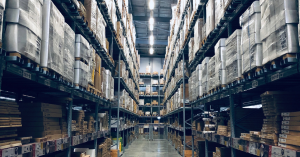Lean principle advocates completely waste-free operations and focuses on value as perceived by the customer. It is most commonly applied in manufacturing but can also be applied in warehouse operations to gain competitive edge.
Importance and Objectives of Warehousing
Importance of a warehouse
Warehousing is a vital component within any organization’s supply chain, it holds high potential for improving lead times, reducing logistics costs and creating competitive advantage.
Challenges of operating a Warehouse
• Lack of accuracy in inventory levels which affects productivity.
• Keeping the correct inventory mix to meet demand.
• Inability to adapt to ever changing market dynamics such as evolution of new channels, reduced lead times, high stock keeping units (SKUs) etc.
• Optimizing the resources through; storage space, labor, material handling equipment etc.
• Reacting to customer fluctuations in demands.
Prerequisites for a lean warehouse
The following are required to create a lean warehouse:
• Foresight- Understanding future trends that affect demand.
• Preparation-Coming up with a process for running the warehouse operations.
• Documentation-developing and deploying a warehouse managing process.
• Analysis-Using data to drive continuous improvements throughout the warehouse.
It also important to build self-awareness and understand each person’s role within the warehouse operations and the importance of synchronized flow within the system.
Focus Areas to Transform into a Lean Warehouse
1. Material Storage and Handling
The material storage and handling can make or break the warehouse operations. Inefficient methods should be replaced by throughput-oriented efficient processes.
Optimized storage results into the following benefits
• Smoother flow of inventory & operations.
• Just-In-Time inventory.
• Effective utilization of resources such as labor, material handling equipment etc.
• Effective utilization of space.
• Meeting customer commitments and higher customer satisfaction.
2. Internal transportation
Unnecessary movement of items inside warehouse add to
Operational cost, Labor cost, Material handling equipment cost, Warehouse rental cost, Lighting and electricity cost, Higher lead time and lower throughput rates
An efficient warehouse storage layout will;
• Have fast-selling products in the front, slow ones at the back.
• With this, time taken for locating, picking and packing items will also be drastically diminished.
3. Inventory Management
Successful inventory management ensures availability of the right product in right amount, and keeps track of existing inventory and its movement. Inventory should not only be available in adequate amounts but also be easily visible and accessible. The most efficient inventory management strategy is the just-in-time method.
Key benefits of inventory management
• Improved product life
• Reduced inventory carrying costs
• Improved agility to respond to varying demand
• Increased picking speed
4. People Movement
Factors influencing people movement and their efficiency in a warehouse are;
• Operational layout of warehouse
• Effectiveness of work stations
• Processes involved in picking and packing
• Movement of material handling equipment
If a particular movement of people is wasteful, it will lead to loss of productive time and resources. In case of manual picking and processing, multiple handling will lead to inefficiency and a risk of items getting broken or damaged.
5. Delays
Any delay in order processing has a negative impact on entire warehousing operations. Delays in people, systems and material, and waiting for replenishment, etc. should be avoided to achieve high productivity. Warehouses incur the cost of wages and all the fixed costs of warehouse and equipment rents, lighting and heating etc. Hence, it’s important to avoid any delay.
6. Over-production/Over-processing
This Leads to excess inventory, incurs costs on resources such as storage space, preservation and their management, causes tied financials and affects competitiveness of the company.
7. Defects
Any action that results in repeats and corrections, such as inventory inconsistencies, billing errors, damaged materials, etc. add to wastage that can and should be avoided. Stop and fix as soon as something goes wrong – defects are easily identifiable, very close to the point of origin. By addressing the root cause of the defect immediately and not accepting nor passing on defects, subsequent problems can be avoided and overall product or service quality improved.
Conclusion
Designing and implementing lean warehouse operations not only brings control, visibility and delivery stability but also reduces lead time, releases financial stress by enabling a high inventory turnover and ultimately reduces the cost to the total logistics.



